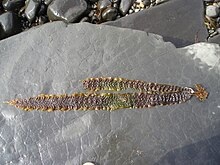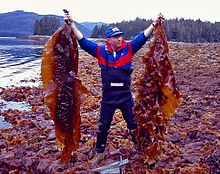Saccharina latissima
| Saccharina latissima | |
|---|---|

| |
| Saccharina latissima | |
| Scientific classification | |
| (unranked): | |
| Superphylum: | |
| Class: | |
| Order: | |
| Family: | |
| Genus: | |
| Species: | S. latissima
|
| Binomial name | |
| Saccharina latissima | |
| Synonyms | |
| |
Saccharina latissima is a brown algae (class Phaeophyceae), of the family Laminariaceae. It is known by the common name sugar kelp,[2] and also sea belt [3] and Devil's apron, due to its shape.[4] It is found in the north east Atlantic Ocean, the Pacific Ocean[5] and the Barents Sea south to Galicia in Spain. It is not found in the Bay of Biscay but is common round the coasts of the British Isles.[6] The species is found at sheltered rocky seabeds.[2]


Description
S. latissima is a yellowish brown colour with a long narrow, undivided blade that can grow to 5 metres (16 ft) long and 20 centimetres (7.9 in) wide. The central band is dimpled while the margins are smoother with a wavy edge. The frond is attached to the rock by stout rhizoids about 5 mm in diameter[3] in the intertidal and sublittoral zones by a claw-like holdfast and a short, pliable, cylindrical stipe.[6]
Ecology
S. latissima is an ecologically important system. It is a primary producer, delivering plant material to the coastal food web. The three-dimensional forests also serve as a habitat for animals, resulting in a high biodiversity. Fish, shellfish and other animals get food and hiding places within these forests.[7]
Distribution
S. latissima is widely distributed around Ireland, Great Britain including the Shetland Islands, and the Isle of Man.[8]
Threats
In 2004, scientists reported a loss in sugar kelp at 80% of the locations in the Skagerrak and 40% of the locations at the West coast of Norway.[9][10][11] The reasons for this loss are not fully understood, but the increase in ocean temperature, high levels of nutrients and the reduction in animal species feeding off the filamentous algae are suggested as the most likely reasons.[12]
References
- ^ Lane, C.E.; C. Mayes; L.D. Druehl; G.W. Saunders (2006). "A multi-gene molecular investigation of the kelp (Laminariales, Phaeophyceae) supports substantial taxonomic re-organization". Journal of Phycology. 42 (2): 493–512. doi:10.1111/j.1529-8817.2006.00204.x.
- ^ a b Bekkby, T., Moy, F. 2011. Developing spatial models of sugar kelp (Saccharina latissima) potential distribution modelling of the kelp species Laminaria hyperborea. ICES Journal of Marine Science 66: 2106–2115.
- ^ a b Dickinson, C.I. 1963. British Seaweeds. The Kew Series
- ^ "Devil's Apron". Webster's Revised Unabridged Dictionary. C. & G. Merriam Co. 1913.
- ^ "Sugar kelp • Saccharina latissima". Biodiversity of the Central Coast. Retrieved 2017-11-09.
- ^ a b Saccharina latissima (Linnaeus) J.V. Lamouroux The Seaweed Site. Retrieved 2011-09-20.
- ^ Christie H, Norderhaug KM, Fredriksen S. 2009. Macrophytes as habitat for fauna. Marine Ecology Progress Series 396: 221-233
- ^ Bunker, F.StP.D., Maggs, C.A., Brodie, J.A., Bunker, A.R. 2017 Seaweeds of Britain and Ireland. Second Edition. Wild Nature Press, Plymouth, UK ISBN 978-0-9955673-3-7
- ^ Rinde E, Christie H. 1992. A survey of rocky bottom communities in the coastal area of Telemark. NINA Oppdragsmelding 133: 1-23.
- ^ Moy, F., Christie, H. 2012. Large-scale shift from sugar kelp (Saccharina latissima) to ephemeral algae along the south and west coast of Norway. Marine Biology Research 8: 309-321
- ^ Bekkby, T., Moy, F. 2011. Developing spatial models of sugar kelp (Saccharina latissima) potential distribution modelling of the kelp species Laminaria hyperborea. ICES Journal of Marine Science 66: 2106–2115
- ^ Moy, F., Stålnacke, P., 2007. Sugar Kelp Project: Analyses of Climate and Environmental Data with Relevance for Sugar Kelp, SFT Report TA-2279/2007, NIVA Report 5454, 210 pp.
